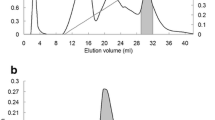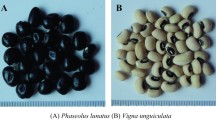Abstract
A survey of 59 species of tropical legume seeds revealed high interspecific variation in proteinaceous capacity to inhibit bovine trypsin (a digestive enzyme) and to agglutinate human (type B, Rh positive) and laboratory rabbit red blood cells. The legume subfamily Mimosoideae was conspicuous for the absence of seeds with very weak trypsin inhibition. Congenerics sometimes differed strongly from each other with respect to both trypsin inhibition and phytohemagglutination. Half the species of seeds displayed no hemagglutinating capacity with one or the other kinds of red blood cells, and in only 27% of the 30 cases where there was some activity did the same species of seed actively agglutinate both species of red blood cells. A species of seed that had hemagglutinating capacity was almost invariably associated with moderate to high levels of trypsin inactivation. While it has been long known that a great diversity of small toxic and potentially defensive molecules occur in legume seeds and that one species of seed often contains several of them, we now feel that it is reasonable to consider legume seeds as also containing a high diversity of potentially toxic protein molecules. A single seed is likely to contain, at the least, three to four classes of defensive compounds, any or all of which, or some in combination, may be the cause of a seed being rejected by a potential seed predator.
Similar content being viewed by others
References
Adams, S.E.I. 1974. Toxic effects ofJatropha curcas in mice.Toxicology 2:67–76.
Becker, P.F. 1984. Tannin structure and function: Keeping our perspective.Am. Nat. 124:134–136.
Chase, T. Jr., andShaw, E. 1967.p-Nitrophenyl-p′-guanidinobenzoate HCl: A new active site titrant for trypsin.Biochem. Biophys. Res. Commun. 29:508–514.
Fellows, L.E., Bell, E.A., Lee, T.S., andJanzen, D.H. 1979. Tetrahydrolathyrine: A new amino acid from seeds ofLonchocarpus costaricensis.Phytochemistry 18:1389–1390.
Gatehouse, A.M.R., Gatehouse, J.A., Dobie, P., Kilminster, A.M., andBoulter, D. 1979. Biochemical basis of insect resistance inVigna unguiculata.J. Sci. Food Agric. 30:948–958.
Hummel, B. 1959. A modified spectrophotometric determination of chymotrypsin, trypsin and thrombin.Can. J. Biochem. 37:1392–1399.
Janzen, D.H. 1969. Seed-eaters versus seed size, number, toxicity and dispersal.Evolution 23:1–27.
Janzen, D.H. 1977. How southern cowpea weevil larvae (Bruchidae:Callosobruchus maculatus) die on nonhost seeds.Ecology 58:921–927.
Janzen, D.H. 1978. The ecology and evolutionary biology of seed chemistry as relates to seed predation, pp. 163–206,in J.B. Harborne (ed.). Biochemical Aspects of Plant and Animal Coevolution. Academic Press, London.
Janzen, D.H. 1981. Lectins and plant-herbivore interactions.Recent Adv. Phytochem. 15:241–258.
Janzen, D.H., andHiggins, M.L. 1979. How hard areEnterolobium cyclocarpum (Leguminosae) seeds?Brenesia 16:61–67.
Janzen, D.H., andLiesner, R. 1980. Annotated checklist of plants of lowland Guanacaste Province, Costa Rica, exclusive of grasses and nonvascular cryptogams.Brenesia 18:15–90.
Janzen, D.H., Juster, H.B., andLiener, I.E. 1976. Insecticidal action of the phytohemagglutinin in black beans on a bruchid beetle.Science 192:795–796.
Janzen, D.H., Lynn, D.G., Fellows, L.E., andHallwachs, W. 1982. The indole alkaloid, hypaphorine andPterocarpus seed protection.Phytochemistry 21:1035–1037.
Janzen, D.H.,Fellows, L.E.,Bell, E.A., andWaterman, P.J. 1986. Why don't Costa RicanLiomys mice (Heteromyidae) eatLonchocarpus seeds (Leguminosae)? In manuscript.
Jayne-Williams, D.J., andBurgess, C.D. 1974. Further observations on the toxicity of navy beans (Phaseolus vulgaris) for Japanese quail (Coturnix coturnix japonica).J. Appl. Bacteriol. 37:149–169.
Laskowski, M., andKato, I. 1980. Protein inhibitors of proteinases.Annu. Rev. Biochem. 49:593–626.
Lee, D.W. 1979. Biological activity of seed proteins in Malesian legumes.Biotropica 11:214–218.
Liener, I.E. 1955. The photometric determination of the hemagglutinating activity of soyin and crude soybean extract.Arch. Biochem. Biophys. 54:223–231.
Liener, I.E. 1979. Phytohemagglutinins, pp. 576–618,in G.A. Rosenthal and D.H. Janzen (eds.). Herbivores, Their Interaction with Secondary Plant Metabolites. Academic Press, New York.
Olsnes, S., andPihl, A. 1973. Isolation and properties of abrin: A toxic protein inhibiting protein synthesis.Eur. J. Biochem. 35:179–185.
Pearce, G., McGinnis, J., andRyan, C.A. 1979. Utilization by chicks of half-cystine from native and denatured proteinase inhibitor protein from potatoes (40415).Proc. Soc. Exp. Biol. Med. 160:180–184.
Rosenthal, G.A., andJanzen, D.H. 1983. Avoidence of nonprotein amino acid incorporation into protein by the seed predatorCaryedes brasiliensis (Bruchidae).J. Chem. Ecol. 9:1353–1361.
Rosenthal, G.A., andJanzen, D.H. 1985. Ammonia utilization by the bruchid beetleCaryedes brasiliensis (Bruchidae).J. Chem. Ecol. 11:539–544.
Rosenthal, G.A., Hughes, C.G., andJanzen, D.H. 1982.L-Canavanine, a dietary nitrogen source for the seed predatorCaryedes brasiliensis (Bruchidae).Science 217:353–355.
Rudiger, H. 1984. On the physiological role of plant lectins.Bioscience 54:95–99.
Ryan, C.A. 1979. Proteinase inhibitors, pp. 599–618,in G.A. Rosenthal and D.H. Janzen (eds.). Herbivores, Their Interaction with Secondary Plant Metabolites. Academic Press, New York.
Stirpe, F., Pession-Brizzi, A., Lorenzoni, E., Strocchi, P., Montanaro, L., andSperti, S. 1976. Studies on the proteins from the seeds ofCroton tiglium and ofJatropha curcas. Toxic properties and inhibition of protein synthesis in vitro.Biochem. J. 156:1–6.
Tannous, R.I., andUllah, M. 1969. Effects of autoclaving on nutritional factors in legume seeds.Trop. Agricul. (Trinidad) 46:123–129.
Turner, R.H., andLiener, I.E. 1975. The use of glutaraldehyde-treated erythrocytes for assaying the hemagglutinating activity of lectins.Anal. Biochem. 68:651–653.
Uy, R., andWold, F. 1977. 1,4-Butanediol diglycyl ether-coupling of carbohydrates to sepharose: Affinity adsorbants for lectins and glycosidases.Anal. Biochem. 81:98–107.
Warsy, A.S., Norton, G., andStein M. 1974. Protease inhibitors from broad bean: Isolation and purification.Phytochemistry 12:2481–2486.
Author information
Authors and Affiliations
Additional information
This is Scientific Paper No. 7342, Project 1791, College of Agriculture Research Center, Washington State University.
Rights and permissions
About this article
Cite this article
Janzen, D.H., Ryan, C.A., Liener, I.E. et al. Potentially defensive proteins in mature seeds of 59 species of tropical leguminosae. J Chem Ecol 12, 1469–1480 (1986). https://doi.org/10.1007/BF01012365
Received:
Accepted:
Issue Date:
DOI: https://doi.org/10.1007/BF01012365




